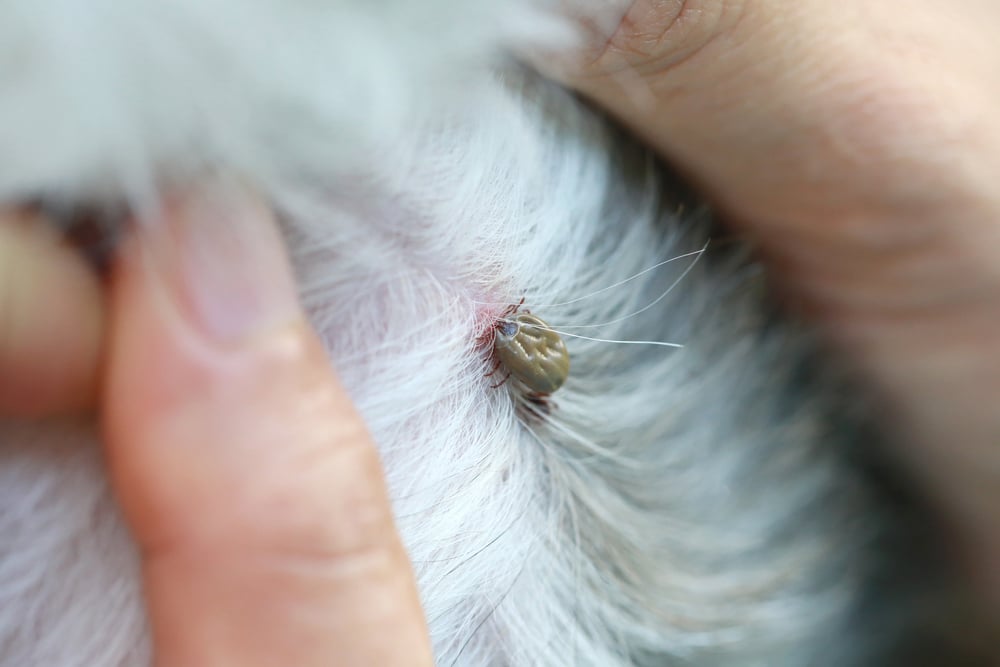As a dog owner, it is essential to know how to keep your furry friend healthy and safe from common health hazards.
One such danger is tick infestation, which can lead to severe health problems for dogs. In this article, we will discuss what happens if a dog gets a tick and how to prevent and treat tick bites.
What are Ticks?
Ticks are small, parasitic arachnids that feed on the blood of their host. There are many species of ticks, but the most common ones that affect dogs are the brown dog tick, the American dog tick, and the lone star tick. Ticks can be found in grassy areas, wooded areas, and even in urban environments.
How Do Dogs Get Ticks?
Dogs can get ticks from being outside in areas where ticks are present. Ticks can attach to a dog’s skin and then feed on their blood.
Dogs can also get ticks from other animals, such as wildlife or other dogs that have been infested with ticks.
What Happens If a Dog Gets a Tick?
Tick bites can cause a variety of health problems for dogs. The most common diseases that ticks can transmit to dogs are Lyme disease, Rocky Mountain spotted fever, and Ehrlichiosis.
These diseases can cause symptoms such as fever, lethargy, loss of appetite, joint pain, and even death.
Signs and Symptoms of Tick Infestation in Dogs
It is crucial to check your dog for ticks regularly, especially if they spend time outside in areas where ticks are present. The following are signs and symptoms of tick infestation in dogs:
- Visible ticks on the skin or fur
- Redness or inflammation around the tick bite
- Itching or scratching
- Fever
- Lethargy
- Loss of appetite
- Joint pain or stiffness
- Swelling in the lymph nodes
How to Check Your Dog for Ticks
To check your dog for ticks, start by running your hands over their entire body, feeling for any lumps or bumps.
Pay particular attention to areas where ticks like to attach, such as the head, neck, ears, and legs. If you find a tick, remove it immediately using the proper techniques.
How to Remove a Tick from Your Dog
To remove a tick from your dog, use a pair of fine-tipped tweezers. Grasp the tick as close to the skin as possible and pull it straight out with steady, even pressure.
Do not twist or jerk the tick, as this can cause the mouthparts to break off and remain in the skin. After removing the tick, clean the area with rubbing alcohol.
Preventing Tick Infestations in Dogs
Preventing tick infestations in dogs is essential to keep them healthy and free from tick-borne diseases. Here are some ways to prevent tick bites in dogs:
- Use tick prevention products: Talk to your vet about using tick prevention products such as tick collars, spot-on treatments, and oral medications.
- Keep your yard clean: Keep your yard free of tall grass and debris, as ticks like to hide in these areas.
- Check your dog regularly: Check your dog for ticks after they spend time outside, and remove any ticks you find promptly.
- Avoid tick-infested areas: Try to avoid areas where ticks are prevalent, especially during tick season.
Tick-Borne Diseases in Dogs
Tick-borne diseases can cause a variety of symptoms in dogs and can be challenging to diagnose. Here are some of the most common tick-borne diseases in dogs:
- Lyme disease: This disease is caused by the bacterium Borrelia burgdorferi and can cause symptoms such as fever, joint pain, lethargy, and loss of appetite.
- Rocky Mountain spotted fever: This disease is caused by the bacterium Rickettsia rickettsii and can cause symptoms such as fever, lethargy, joint pain, and loss of appetite.
- Ehrlichiosis: This disease is caused by the bacterium Ehrlichia canis and can cause symptoms such as fever, lethargy, loss of appetite, and swollen lymph nodes.
Treatment for Tick Bites in Dogs
If your dog has been bitten by a tick, it is essential to remove the tick promptly and watch for any signs of illness.
If your dog develops symptoms such as fever, lethargy, or loss of appetite, contact your vet immediately. Treatment for tick-borne diseases in dogs may include antibiotics, supportive care, and hospitalization in severe cases.
Home Remedies for Tick Bites in Dogs
There are several home remedies that you can use to treat tick bites in dogs, such as:
- Applying a paste of baking soda and water to the tick bite
- Applying a drop of lavender essential oil to the tick bite
- Applying a cold compress to the tick bite to reduce swelling
However, it is essential to consult with your vet before using any home remedies on your dog.
When to See a Vet for Tick Bites
If your dog has been bitten by a tick and develops any symptoms of tick-borne diseases, you should contact your vet immediately.
Additionally, if you are unsure how to remove a tick properly or if you suspect that the tick has been attached to your dog for an extended period, you should take your dog to the vet.
Conclusion
Ticks are a significant health hazard for dogs, and it is crucial for pet owners to understand what happens if their dog gets a tick and how to prevent and treat tick bites.
By following the tips in this article, you can help keep your furry friend healthy and free from tick-borne diseases.
FAQs
Can ticks kill dogs?
Ticks can transmit diseases that can be deadly to dogs, so it is essential to prevent and treat tick bites promptly.
How long does it take for a tick to transmit disease to a dog?
It can take several hours to several days for a tick to transmit disease to a dog.
What is the best way to remove a tick from a dog?
The best way to remove a tick from a dog is to use a pair of fine-tipped tweezers and pull the tick straight out with steady, even pressure.
Can humans get tick-borne diseases from dogs?
Yes. Humans can get tick-borne diseases from dogs, so it is essential to protect both yourself and your furry friend from tick bites.
Can tick-borne diseases in dogs be treated?
Yes, tick-borne diseases in dogs can be treated with antibiotics and supportive care, but early detection and treatment are essential for a successful outcome.
Thank you for reading this article on what happens if a dog gets a tick. If you have any further questions or concerns, please don’t hesitate to contact your vet for advice.
And always remember to take precautions to protect your dog from tick bites, as they can be a severe threat to their health and wellbeing.


